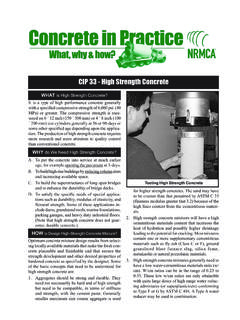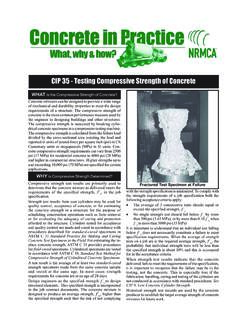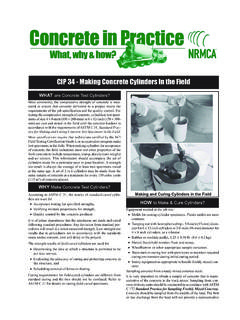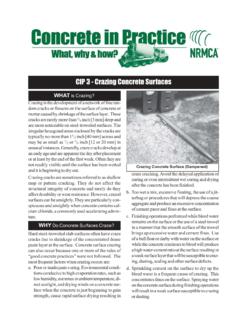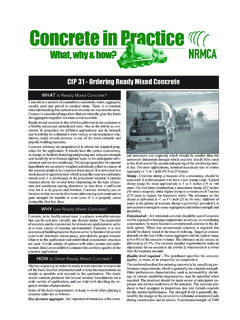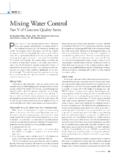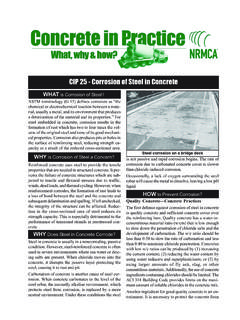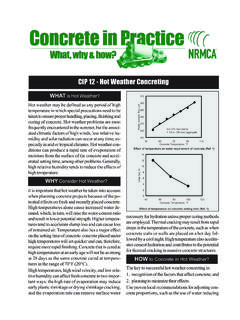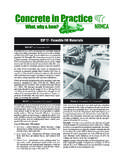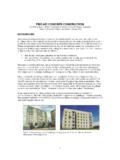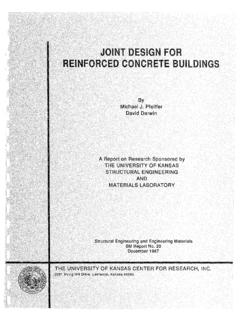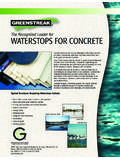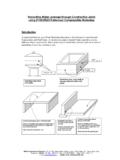Transcription of CIP 6 - Joints in Concrete Slabs on Grade
1 CIP 6 - Joints in Concrete Slabs on GradeWHATare Joints ?WHY are Joints Constructed? Concrete expands and shrinks with changes in mois-ture and temperature. The overall tendency is to shrinkand this can cause cracking at an early age. Irregularcracks are unsightly and difficult to maintain but gen-erally do not affect the integrity of Concrete . Joints aresimply pre-planned cracks. Joints in Concrete Slabs canbe created by forming, tooling, sawing, and placementof joint forms of Joints are:a. Contraction Joints are intended to create weak-ened planes in the Concrete and regulate the loca-tion where cracks, resulting from dimensionalchanges, will Isolation or expansion Joints separate or isolateslabs from other parts of the structure, such as walls,footings, or columns; and driveways and patios fromsidewalks, garage Slabs , stairs, lightpoles and otherpoints of restraint.
2 They permit independent verti-cal and horizontal movement between adjoining partsof the structure and help minimize cracking whensuch movements are Construction Joints are surfaces where two suc-cessive placements of Concrete meet. They are typi-cally placed at the end of a day s work but may berequired when Concrete placement is stopped forlonger than the initial setting time of Concrete . Inslabs they may be designed to permit movementand/or to transfer load. The location of constructionjoints should be planned. It may be desirable toachieve bond and continue reinforcement through aconstruction in Concrete cannot be prevented entirely, butthey can be controlled and minimized by properly de-signed Joints . Concrete cracks because:a. Concrete is weak in tension and, therefore, if itsnatural tendency to shrink is restrained, tensilestresses that exceed its tensile strength can develop,resulting in At early ages, before the Concrete dries out, mostcracking is caused by temperature changes or bythe slight contraction that takes place as the con-crete sets and hardens.
3 Later, as the Concrete dries,it will shrink further and either additional cracks mayform or preexisting cracks may become provide relief from the tensile stresses, are easyto maintain and are less objectionable than uncontrolledor irregular to Construct Joints ? Joints must be carefully designed and properly con-structed if uncontrolled cracking of Concrete flatworkis to be avoided. The following recommended prac-tices should be observed:a. The maximum joint spacing should be 24 to 36 timesthe thickness of the slab . For example, in a 4-inch[100 mm] thick slab the joint spacing should be aboutSaw cutTooledWall or ColumnExpansion joint materialSlab on gradeColumnContraction jointsintersect at diagonalsof the squareForm openingswhichwill be filled afterfloor has hardenedConcrete cracks below jointsSlab isolated from footingKeyedDoweledContraction JointsIsolation JointsConstruction Joints1979, 1989 AND 1998 Follow These Rules for Proper Jointing1.
4 Plan exact location of all Joints , including timing of contraction joint sawing before Provide isolation Joints between Slabs and columns, walls and footings, and at junctions of driveways withwalks, curbs or other Provide contraction Joints and joint filling materials as outlined in in Concrete Construction, ACI , AmericanConcrete Institute, Farmington Hills, for Concrete Floor and slab Construction, , American Concrete Institute, Farmington Hills, on Grade , ACI Concrete Craftsman Series CCS-1,American Concrete Institute, Farmington Hills, Planning Primer, Concrete Construction, Bruce A. Suprenant, Sawcutting Joints in Concrete , Con-crete Construction, January feet [3 m]. It is further recommended that jointspacing be limited to a maximum of 15 feet [ m].b. All panels should be square or nearly so. The lengthshould not exceed times the width. AvoidL-shaped For contraction Joints , the joint groove should havea minimum depth of 1/4the thickness of the slab ,but not less than 1 inch [25 mm].
5 Timing ofjointing operations depends on the method used: Preformed plastic or hard board joint strips areinserted into the Concrete surface to therequired depth before finishing. Tooled Joints must be run early in the finishingprocess and rerun later to ensure groove bondhas not occurred. Early-entry dry-cut Joints are generally run 1 to4 hours after completion of finishing, dependingon the Concrete s setting characteristics. Thesejoints are typically not as deep as those ob-tained by the conventional saw-cut process,but should be a minimum of 1 inch [25 mm] indepth. Conventional saw-cut Joints should be runwithin 4 to 12 hours after the Concrete hasbeen Raveling during saw cutting is affected by thestrength of the Concrete and aggregate character-istics. If the joint edges ravel during sawing, it mustbe delayed. However, if delayed too long, sawingcan become difficult and uncontrolled cracking Use premolded joint filler such as asphalt-impreg-nated fiber sheeting, compressible foam strips, orsimilar materials for isolation Joints to separate slabsfrom building walls or footings.
6 At least 2 inches[50 mm] of sand over the top of a footing will alsoprevent bond to the To isolate columns from Slabs , form circular orsquare openings, which will not be filled until afterthe floor has hardened. slab contraction Joints shouldintersect at the openings for columns. If square open-ings are used around columns, the square should beturned at 45 degrees so the contraction Joints inter-sect at the diagonals of the If the slab contains wire mesh, cut out alternatewires, or preferably discontinue the mesh, acrosscontraction Joints . Note that wire mesh will not pre-vent cracking. Mesh tends to keep the cracks andjoints tightly Construction Joints key the two edges of the slabtogether either to provide transfer of loads or to helpprevent curling or warping of the two adjacent metal keys are sometimes used for in-terior Slabs , however, a beveled 1 by 2 inch [25 by50 mm] strip, nailed to bulkheads or form boards,can be used in Slabs that are at least 5 inches [125mm] thick to form a key which will resist verticalloads and movements.
7 Keyed Joints are not recom-mended for industrial floors. Metal dowels shouldbe used in Slabs that will carry heavy loads. Dowelsmust be carefully lined up and parallel or they mayinduce restraint and cause random cracking at theend of the Joints in industrial floors subject to heavy traffic re-quire special attention to avoid spalling of joint Joints should be filled with a material capableof supporting joint edges. Manufacturer s recom-mendations and performance records should bechecked before use.
